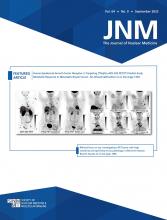Abstract
Recent innovative strategies have dramatically redefined the therapeutic landscape for treating multiple myeloma patients. In particular, the development and application of immunotherapy and high-dose therapy have demonstrated high response rates and have prolonged remission duration. Over the past decade, new morphologic or hybrid imaging techniques have gradually replaced conventional skeletal surveys. PET/CT using 18F-FDG is a powerful imaging tool for the workup at diagnosis and for therapeutic evaluation allowing medullary and extramedullary assessment. The independent negative prognostic value for progression-free and overall survival derived from baseline PET-derived parameters such as the presence of extramedullary disease or paramedullary disease, as well as the number of focal bone lesions and SUVmax, has been reported in several large prospective studies. During therapeutic evaluation, 18F-FDG PET/CT is considered the reference imaging technique because it can be performed much earlier than MRI, which lacks specificity. Persistence of significant abnormal 18F-FDG uptake after therapy is an independent negative prognostic factor, and 18F-FDG PET/CT and medullary flow cytometry are complementary tools for detecting minimal residual disease before maintenance therapy. The definition of a PET metabolic complete response has recently been standardized and the interpretation criteria harmonized. The development of advanced PET analysis and radiomics using machine learning, as well as hybrid imaging with PET/MRI, offers new perspectives for multiple myeloma imaging. Most recently, innovative radiopharmaceuticals such as C-X-C chemokine receptor type 4–targeted small molecules and anti-CD38 radiolabeled antibodies have shown promising results for tumor phenotype imaging and as potential theranostics.
Footnotes
Learning Objectives: On successful completion of this activity, participants should be able to describe (1) important news in multiple myeloma treatment; (2) the prognostic value of FDG PET/CT in different disease stages; and (3) the added value of non-FDG tracer imaging, radiomics, and whole-body functional MRI.
Financial Disclosure: This work has been supported in part by grants from the French National Agency for Research “France 2030 investment plan” Labex IRON (ANR-11-LABX-18-01), Equipex ArronaxPlus (ANR-11-EQPX-0004), and I-SITE NExT (ANR-16-IDEX-0007) and by a grant from INCa-DGOS-INSERM_12558 (SIRIC ILIAD). Dr. Moreau has received honoraria from or is on the advisory boards for Janssen, Celgene, Sanofi, Abbvie, Takeda, Amgen, and GSK. Dr. Nanni is a consultant for Sanofi-Aventis, a case revisor for Keosys, and on the advisory board for the EANM Oncology Theranostic Committee and the AIMN Oncology Committee. Dr. Kraeber-Bodéré is a consultant for PentixaPharm and Novartis-AAA, a case revisor for Keosys, and a member of the EANM Oncology Theranostic Committee. The authors of this article have indicated no other relevant relationships that could be perceived as a real or apparent conflict of interest.
CME Credit: SNMMI is accredited by the Accreditation Council for Continuing Medical Education (ACCME) to sponsor continuing education for physicians. SNMMI designates each JNM continuing education article for a maximum of 2.0 AMA PRA Category 1 Credits. Physicians should claim only credit commensurate with the extent of their participation in the activity. For CE credit, SAM, and other credit types, participants can access this activity through the SNMMI website (http://www.snmmilearningcenter.org) through September 2026.
Published online Aug. 17, 2023.
- © 2023 by the Society of Nuclear Medicine and Molecular Imaging.
Immediate Open Access: Creative Commons Attribution 4.0 International License (CC BY) allows users to share and adapt with attribution, excluding materials credited to previous publications. License: https://creativecommons.org/licenses/by/4.0/. Details: http://jnm.snmjournals.org/site/misc/permission.xhtml







